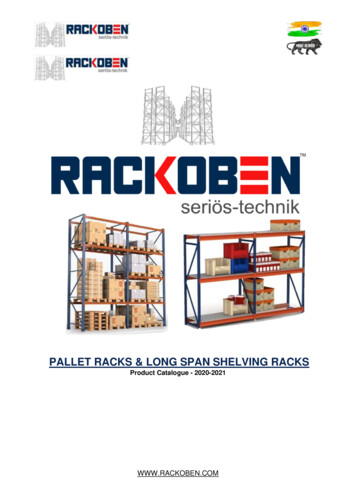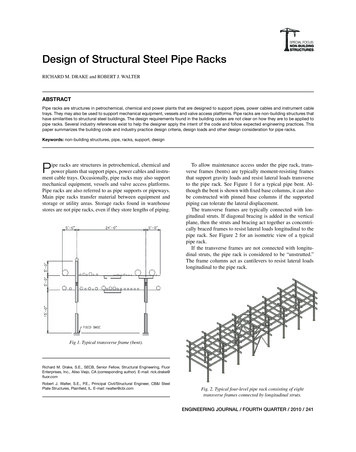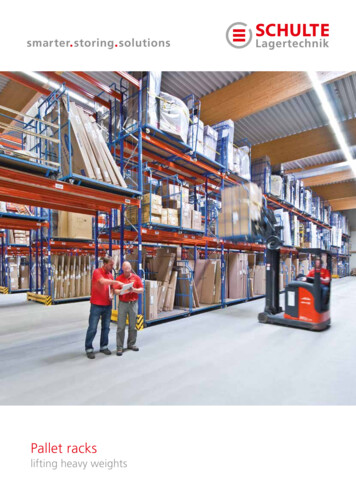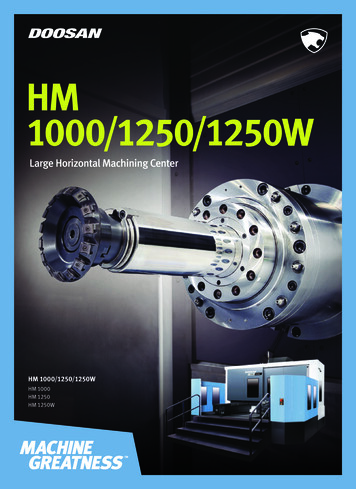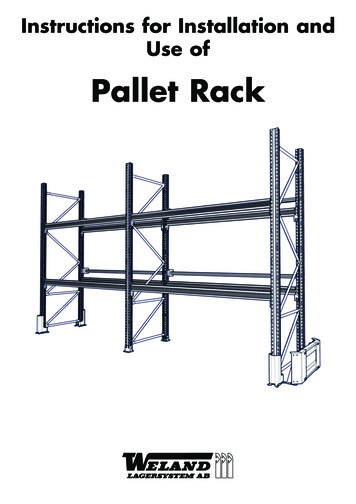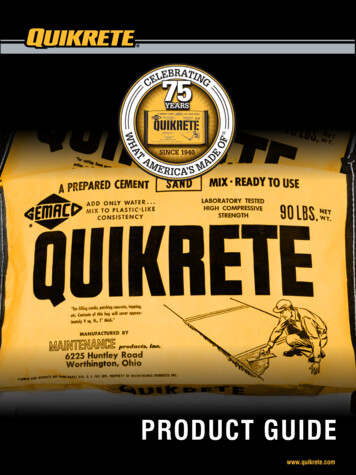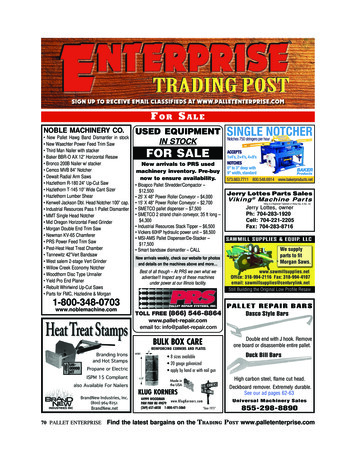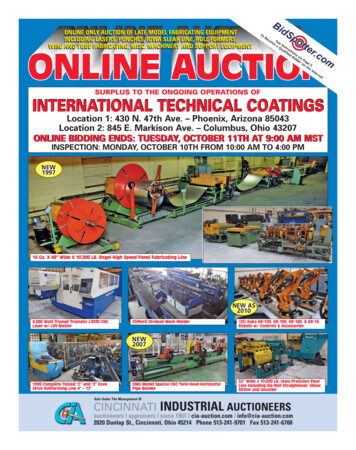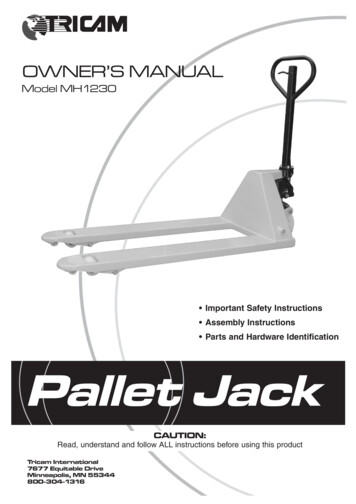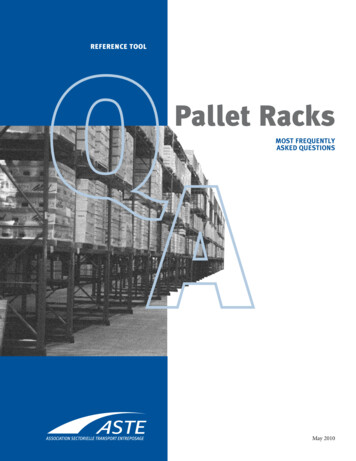
Transcription
Reference toolPallet RacksMost FrequentlyAsked QuestionsMay 2010
What is a pallet rack?A pallet rack is a structure mainly composed of braces and beamsand designed to carry loads, which are usually palletized, in the courseof storage operations.accessory forprotection againstfalling objectsrow spacerhorizontal crossaisle tiebracewall spacer*diagonalbraceuprightframecolumntunnel baywall end stoprated load plaqueend of row protectoresafety barpalletrackpalletsupport bart*Not recommendedRack components and accessories(Illustration: Technirack)2palletizedloadloadsupportbeamlisse
TABLE of ContentsPAGE1A - Can the pallet rack be attached to the structure of the building? . . . . . . . . . . . . . . . . . . . . . . . 4B - Are wall spacers recommended? . . . . . . . . . . . . . . . . . . . . . . . . . . . . . . . . . . . . . . . . . . . . . . . . . . . 4C - Does the pallet rack need to be anchored to the floor? . . . . . . . . . . . . . . . . . . . . . . . . . . . . . . . . 42A - Can we adapt or repair the pallet rack ourselves? . . . . . . . . . . . . . . . . . . . . . . . . . . . . . . . . . . . . 5B - Should we be replacing damaged components? . . . . . . . . . . . . . . . . . . . . . . . . . . . . . . . . . . . . . . 53Should there be a rated load identification plate on the pallet rack? . . . . . . . . . . . . . . . . . . . . . . . 64Are safety pins compulsory? . . . . . . . . . . . . . . . . . . . . . . . . . . . . . . . . . . . . . . . . . . . . . . . . . . . . . . . . 75Are safety bars compulsory? . . . . . . . . . . . . . . . . . . . . . . . . . . . . . . . . . . . . . . . . . . . . . . . . . . . . . . . . . 76Are support bars recommended if the load is too big to rest directly on the beams? . . . . . . . . . . 87 Should there be some clearance left over for the placement of loads in the pallet rack? . . . . . . 98 Should devices be added to prevent falling objects? . . . . . . . . . . . . . . . . . . . . . . . . . . . . . . . . . . . . 99Can single-use pallets (disposable or limited-use pallets) be used in a pallet rack? . . . . . . . . 1010A - Do forklift operators have to wear a harness when driving an order picker? . . . . . . . . . . . . . 11B - Are rear safety bars recommended for forklift operatorsworking in a standing position? . . . . . . . . . . . . . . . . . . . . . . . . . . . . . . . . . . . . . . . . . . . . . . . . . . 1211Are column guards recommended? . . . . . . . . . . . . . . . . . . . . . . . . . . . . . . . . . . . . . . . . . . . . . . . . . . 1212 Should earthquake hazards be factored into pallet rack design? . . . . . . . . . . . . . . . . . . . . . . . . 1413A - Do workers need to be trained in order to report any damage to the pallet rack? . . . . . . . . . 14B - Is it necessary to have an inspection and preventive maintenance programfor the pallet racks? . . . . . . . . . . . . . . . . . . . . . . . . . . . . . . . . . . . . . . . . . . . . . . . . . . . . . . . . . . . . 143
1A - Can the pallet rack be attached to the structure of the building?No.The pallet rack must be stand-alone. Any fastening to building structures is generally forbidden, unless thebuilding was specially designed for that purpose.If it is absolutely necessary to attach a pallet rack to a structural component, one must make sure that any forcesthereby transferred to the building do not exceed the specifications of the National Building Code (NBC).B - Are wall spacers recommended?No.For the same reasons as why the pallet rack cannot be attached to the building structure.A wall spacer is used to connect a pallet rack upright frame to an adjacent wall in order to keep them evenly spaced.C - Does the pallet rack need to be anchored to the floor?Yes.Pallet racks are not designed to withstand an impact from a forklift truck. When pallet racks are used withforklifts, ground anchoring is always recommended for increased stability.Expansion bolts can be used to anchor pallet racks because they are resistant to shearing and pulling.In some situations, particularly when the floor concrete does not afford enough of a purchase for standardanchor bolts, chemical anchoring can be used. Chemical anchoring consists in filling the anchor hole witha compound — epoxy resin, for example.horizontal bracecolumnbase platebeam bracketBase plate and anchor bolts(Illustration: Technirack)4
Anchoring the base plate1 - All base plates are anchored with at least one anchor bolt. Using two anchors instead of one helpsprevent the base plate from pivoting in the event of an impact. However, the anchor bolts must bespaced far apart to prevent the floor concrete from chipping or cracking.2 - Anchor bolts must be installed and tightened as per the bolt manufacturer’s specifications.3 - The concrete floor around base plates must be free of cracks and fissures. The ground and foundationsmust be strong enough to hold up the loads applied. When pallet racks are installed, the thickness andflatness of the floor slab must be considered.2A - Can we adapt or repair the pallet rack ourselves?No.Any changes must be previously approved by the pallet rack manufacturer or by an engineer.The configuration of beams and braces must be specified by the manufacturer in the installation plans andspecifications. For example, any modification of the height of a brace will alter the load capacity and stabilityof a pallet rack. The racks must be installed by the manufacturer itself, by one of its representatives or bycontractors specialized in this field.The company using the pallet rack must keep the plans and specifications on file — available and up to date.Any modification to the pallet racks not envisaged in the original specifications, particularly in reference totheir configuration, must be submitted to the pallet rack manufacturer or to an engineer before work canproceed. A new rated load capacity for the installation as well as its specifications and tolerances must bere-computed by the manufacturer or an engineer.B - Should we be replacing damaged components?Yes.Any damaged components must always be replaced with new, identical components or parts equivalent tothe original components, as per the manufacturer’s or engineer’s directives. Cracked or split members mustbe replaced. Any parts with evidence of damage caused by corrosion must be repaired or replaced.The configuration of any diagonal braces on the pallet racks may not be changed in the course of a repair job.Repairs must always be done as per manufacturer specifications, unless a repair method is approved by anengineer, such as to guarantee strength at least equal to that of the original component.Any repairs such as straightening of bent components, welding sections of components together, or sleevingor splicing damaged sections carried out without prior consultation with the manufacturer , one of itsrepresentatives or an engineer is strictly forbidden.5
3Should there be a rated load identification plate on the pallet rack?Yes.There must be a visible and readable rated load identification plate affixed to the rack.The pallet rack’s rated load must be observed. Localized overloading in a pallet rack can permanently deformbeams or their connectors.This ID plate must be corrosion-resistant.The ID plate must contain the following information: Manufacturer’s name Maximum permissible load per alveole Permissible load for an entire bayThe alveole is the name given each space on a pallet rack, generally designed to accept palletized loads.A bay is a vertical stack of alveoles between two pallet rack upright frames.It is also recommended to add the following mention of the rated load ID plate:“No changes may be made to the pallet rack’s rated load or configuration, unless previously approvedby the manufacturer or an engineer.”ABC Pallet Racks Inc.Rated load of the pallet rack Maximum permissible load per alveole:Kg Total permissible load per bay:KgCaution: No changes may be made to the pallet rack’s rated loador configuration, unless previously approved by the manufactureror an engineer.6
4Are safety pins compulsory?Yes.Safety pins are components inserted into a beam connector to prevent the beam from accidentally separatingfrom the upright frame.These pins can be simple cotter pins, a bolt with a nut, etc.There must be safety pins at either end of every beam.They must be designed to prevent intentional or accidental removal. In the case of bolts, the nuts must betightened.At the top of the pin,a small end stop preventsit from being intentionallyor unintentionally removedfrom the column.end stopRecommended as a lock pin designThe pin is inserted in thecolumn with a hammer,and thus cannot be intentionally orunintentionally removed from it.However, particular attentionshould be given to the wearand tear on each side of the stem.wing nutstemRecommended as a lock pin designThe pin is not securelyattached, since it canbe intentionally orunintentionally removed.Not recommended as a lock pin design5Are safety bars compulsory?Yes.Safety bars are components usually installed in pairs, perpendicular to the rack beam, to prevent the beam fromaccidentally separating from the upright frame column, and there are different systems for inserting them.Safety bars are installed on the beams to help support the palletized loads. They are not designed to supportloads by themselves; this is what the beams are for.The safety bars must be connected to the beams.7
6Are support bars recommended if the load is too big to rest directly on the beams?Yes.As opposed to safety bars, support bars are designed to carry a load by themselves when the dimensions,awkwardness or type of load prevent placement directly on the beams.These support bars provide enough clearance for truck forks to be inserted under loads that are not ona pallet (wooden beams, for example).horizontalbracediagonalbracecompartment end plateload supportbeamRack components and accessories(Illustration: Technirack)8
7Should there be some clearance left over for the placement of loads in the pallet rack?Yes.Built-in clearance is an important component of pallet rack design. If there is not enough clearance, there is anincreased risk of damage to loads or racks. The forklift manufacturer should be consulted to make sure enoughclearance is built into the pallet rack design to allow forklift operators to handle loads safely.To find out how much clearance is required, consult tables 5 and 6 of the safety guide titled “Safety ofPallet Racks”.8Should devices be added to prevent falling objects?Yes, if there is a risk of anything falling from a pallet rack.Accessories for protection against falling objects are installed on the beams or across the back face of an alveoleto prevent things from falling, particularly if there are alveoles located above the pallet rack tunnels or of therear side of some alveoles face walkways, warehouse aisles, throughways, work stations or other areas wherepeople are likely to be found.It should be forbidden to set up a work station in a main or warehouse aisle.The pallet rack tunnel is a throughway left open in a row of pallet racks for an aisle to go through.Accessories for protection against falling objects usually consist of latticed panels or metal gratings. These screensare used from a height of 1 m (40") to a height above the warehoused loads. The loads should not butt againstthese screens.safety barbeambracketpalletsupportbaraccessoryfor protection againstfalling objectsRack accessories: safety bars, pallet support barsand accessories for protection against falling objects(Illustration: Technirack)9
9Can single-use pallets (disposable or limited-use pallets) be used in a pallet rack?No.Pallets are loading platforms used to support one large or many small packages all combined into a palletizedload. It can also be considered part of a product’s packaging.There are stated standards for the design and manufacture of pallets and skids.Single-use pallets are designed to be used only once and are therefore considered to be part of the packaging.These low-cost pallets are usually made of low-quality wood, particle board, cardboard or polystyrene foam.If a limited-use pallet is to be stored on the pallet rack, it is recommended to place a reusable pallet underneath.The only pallets that can be used are those that are compatible with the pallet rack in terms of dimensions, weight,strength, and so on. Pallets must have sufficient capacity to support a load without breaking or deforming.Pallets must be inspected regularly.Pallets should be discarded if they are damaged or defective as in the cases below: Missing, incomplete, split or broken stringer Missing, incomplete, split or broken board Nails sticking outBroken stringerMissing and broken boardsDeficient stringerSplit boardsSplit stringerBroken boardProtruding nailsBroken boardDamaged pallets to be rejected(Illustration: Technirack)10
10A - Do forklift operators have to wear a harness when driving an order picker?Yes.Because the driving station on an order picker elevates, their operators must wear a harness, as stated inthe Act Respecting Occupational Health and Safety (section 346).Order pickers are designed for manual preparation of orders. The operators work in a standing position ina cab that can rise several metres, enabling them to custom-prepare orders and restock the racks.Order picking truck(Illustration: Technirack)11
B - Are rear safety bars recommended for forklift operators working in a standing position?Yes.The safety device consists of one or two bars installed behind the standing operator of a narrow-aisle straddletruck or a reaching carriage truck.This safety device is designed to prevent objects transversal to the truck (e.g. beams) from entering the operator’sdriving cab when the forklift is reversing.Any changes made to forklift trucks must be previously approved by the manufacturer or by an engineer.This safety device must be in compliance with the specifications outlined in section 7.28 of the Safety Standardfor Low Lift and High Lift Trucks ASME B56.1 (1993-A.1995).forkreach forkback barprotectingtheoperatorback barprotectingtheoperatoroutriggerNarrow aisle straddle truck(Illustration: Technirack)11outriggerReach fork lift truck(Illustration: Technirack)Are column guards recommended?Yes.The purpose of protecting uprights and columns, whether or not they are attached to pallet rack braces, is toincrease their resistance to impacts from forklifts. They are separated into two major groups: Column guards (bumper, stopper, angle deflector, etc.) Row end protector (guardrail, bumper post, etc.)Incidentally, protection can be increased by doubling the upright columns.12
upright framecolumnbeamanchor boltbeam bracketupright framecolumnbase platehorizontalbrace consistingof a columnanchor boltcorner guardbase plateBuilt-in column protection(Illustration: ardcornerguardCant-leg frame(Illustration: Technirack)Protective barrier separating the pedestrianwalkway and the main aisle(Illustration: Technirack)Row end protector(Illustration: Technirack)13
12Should earthquake hazards be factored into pallet rack design?Yes.Pallet rack users who wish to have earthquake risks factored into their design should so inform the manufacturer.The manufacturer will then consult seismic data provided in the National Building Code, notably in Table C-2of its Appendix C, Design Data for Selected Locations in Canada.Pallet racks designed to withstand overloads attributable to earthquakes are safer because they comprise morebracing and stronger anchoring. They are more resistant to domino-type collapsing if one of the rows is hit bya forklift. This type of pallet rack is recommended in big-box stores open to the public and wherever hazardousmaterials are stored.13A - Do workers need to be trained in order to report any damage to the pallet rack?Yes.Workers must be trained to be in a position to detect and report easily visible irregularities in the storage system.In addition, the forklift operators need to be informed of the effect of machinery impacts with the pallet racks.B - Is it necessary to have an inspection and preventive maintenance programfor the pallet racks?Yes.Pallet rack users must consistently apply the inspection and preventive maintenance program. This programincludes daily monitoring as well as planned inspections (both visual and in-depth).The purpose of daily monitoring is to report easily visible incongruities such as the following: Bent components Poorly positioned loads Missing safety pins Loose anchor bolts Cluttered warehouse aisles and main aislesPlanned inspections are conducted both visually and with specific measuring instruments (levels or precisionmetal rulers) to assess the verticality of the upright columns and any deformations in the beams or uprights.It may become necessary to unload entire sections of a pallet rack in order to measure the permanent deformationof certain components. The content and frequency of planned inspections can be determined in consultationwith the pallet rack manufacturer.loadloadhorizontalposition of theload supportbeamactual positionof the loadsupport beamconcreteslab14Loaded beam deflection(Illustration: Technirack)
Damaged column:The weld near the base plategave way(Photo: Maurice Vézinet)Column damagedby repetitive impacts fromthe front and the side(Front view)(Photo: Maurice Vézinet)Same damaged column(Side view)(Photo: Maurice Vézinet)Galvanized steel columndamaged by impacts fromthe rear (Rear view)Photo: Maurice Vézinet)Same damaged column(Side view)Photo: Maurice Vézinet)Damaged double column:Substandard weld,worn and deformed columndue to friction with the lifttruck outriggers(Photo: Maurice Vézinet)Corroded steel columnworn by friction and rewelded(Photo: Maurice Vézinet)Damaged column guard(Photo: Maurice Vézinet)Damaged column repairedby electrode welding(Photo: Maurice Vézinet)15
The information and illustrations contained herein are drawnfrom a document titled “Safety of Pallet Racks”, a joint publicationof the Commission de la santé et de la sécurité du travail auQuébec (CSST) and the Association Sectorielle TransportEntreposage (ASTE).Please refer to the above-mentioned guide for further details.ContributorsPierre Bouliane, safety consultantAssociation Sectorielle Transport Entreposage (ASTE)François Fontaine, P.Eng.inspector, safety inspection team leaderCommission de la santé et de la sécurité du travail au Québec (CSST)regional directorate for Saint-Jean-sur-Richelieu6455 Jean-Talon east, Suite 301Montréal, (Québec)H1S 3E8Telephone : qc.ca
For the same reasons as why the pallet rack cannot be attached to the building structure. A wall spacer is used to connect a pallet rack upright frame to an adjacent wall in order to keep them evenly spaced. c - Does the pallet rack need to be anchored to the floor? Yes. Pallet racks are not designed to withstand an impact from a forklift truck.
